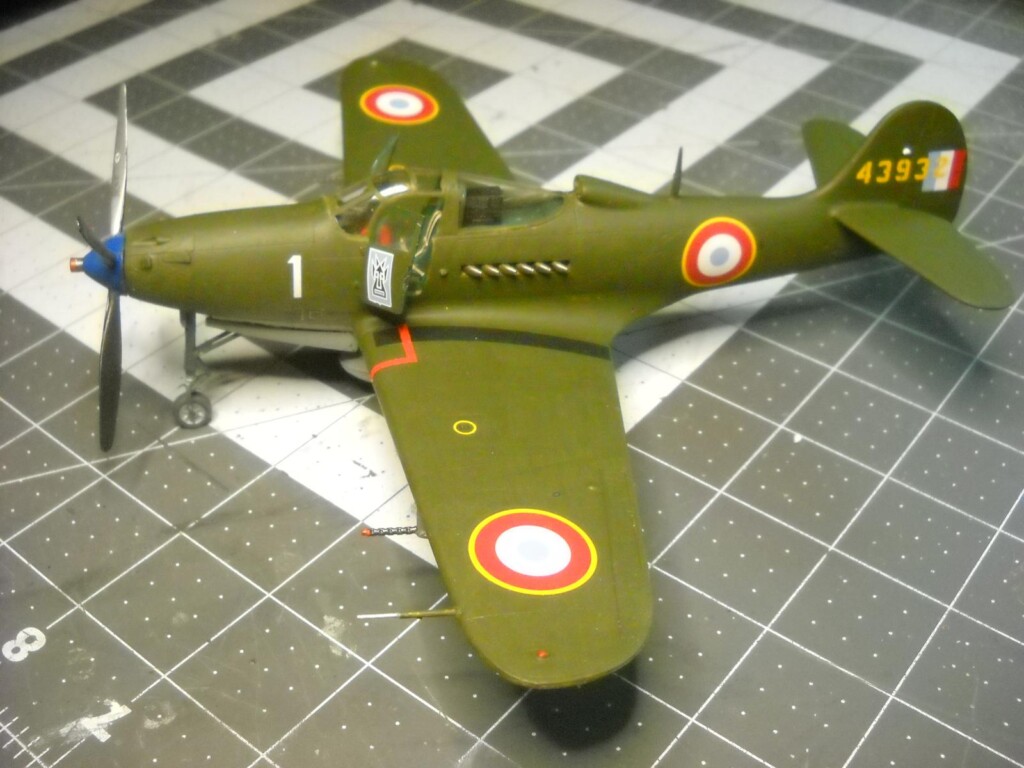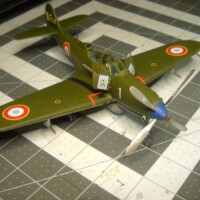French 4-Bladed P-39
For an aircraft with such a bad reputation, it was flown by several Air Forces. The VVS could not get enough of the Kobra, Over 4500 P-39s were supplied to the Soviets. Australia received a few and both the Free French and Italian Co-Belligerent Air Force were supplied with P-39s. Portugal used interned P-39s. The Soviets removed the wing guns, ammo feeds, and boxes. They also removed most of the radio equipment, lightening the Kobra so it would perform better. Both the Soviets and the French acquired P-39 Block P-39Q-21 and Q-25 with the 4-blade Aeroproducts prop. Only these blocks were fitted with the 4-blade prop as it worsened the lateral stability of the airplane. Also, the Q-25 block did away with the wing guns, and all appear to have been sent to the VVS
I wanted a 4-blade prop P-39, as it does look different. Eduard shows several French variants with the 4-bladed prop, but only one is actually a Q-21. The remaining were all 3-blade Curtiss or Aeroprducts Propeller. This is the subject of this build. The P-39 is fairly well represented in1/48th scale. The first kit was a 1/46th (?) scale kit by Revell. I have not seen this kit so I cannot comment on it. The next kit was the ahead-of-its-time Monogram kit of 1969. This kit is considered to be the first of the "super kits" where detail takes priority. Eduard burst on the scene with their first mainstream kit of the P-39. Almost any version of the P-39/P-400/Airacobra I can be built from this kit. Finally, Hasegawa came out with a nice P-39, but there are questions about its tail.
I was fortunate as I made a trade with a person on Hyperscale for a P-400. When I received the kit I found it had decals for kit No.8063, which when I checked the serial numbers for the French aircraft was a P-39Q-21: a 4-bladed prop. But it was missing the Squadron codes. The codes were provided by a gentleman from Hyperscale. I knew what I was to build.
The variant chosen is a P- 39Q-21-BE serial number 44-3932. The serial number is important with P-39s as they look a lot alike and it is the only way of knowing which prop was installed. One needs to carefully choose the parts for the variant you are building. Check Hyperscale's Reference section as I seem to remember someone compiling a list of what parts to use for each version. Construction was straightforward with no major glitches. Bell had their own ideas about colors, and the interior was painted in Dull Dark Green, with the landing gear in either Medium Green or Dull dark green. Often the nose well was in Yellow Zinc Chromate, and the gear legs could be in Neutral Grey. As with all Eduard kits, you need to remove any excess plastic and paint from the mating surfaces. And follow the instructions. There are two small levers, parts C-41 and C-43 which are small and fragile. Their mounting holes are a bit nebulous, so I drilled out the holes and used fine wire with a blob of thick Superglue as the knob.
I needed a bit of filler here and there, where ( a lot of "ere"s) I was overzealous with trimming. Make sure you open up the holes you need to. It seems the earlier P-39 kits came with molded nose wi=eights, but later kits do not. So I weighed one of Eduard's weights and found it was 19 grams. Some have said the trailing edges of the wing are too thick, so the edges need to be thinned if it bothers you. When the kit was finished, and the seams were to my liking the kit was wiped off with Isopropyl Alcohol to clean it.
The Free French P-39s were painted in Olive Drab and Neutral Grey. Vallejo colors were used. When dry, a coat of Future Floor Wax was added. The Eduard decals were then applied using the Microscale System, and the decals reacted well, snuggling down tight. Any excess glue and chemicals were removed with water and a soft rag. When dry a second coat of Future was applied. When the second coat of future had cured, a clear flat was sprayed on. I then attached the doors, canopy, prop (painted Aluminum), and remaining bits.
The model represents a Bell P-39Q-21BE serial number 44-3932 coded "1" of G.C.III/6 "Rousillon" of the Free French Air Force in 1944. The Eduard P-39 is a nice kit that is not too fiddly and can be found fairly easily. It builds into a nice model, and the "Profipak" and dual Combo versions of the kit include masks, etched parts, and lots of decals. I can recommend this kit to everyone.
Bruce








Excellent result on the Eduard Airacobra, Bruce!
Nicely done, I love the Eduard P-39's, they are superb aren't they...
2 attached images. Click to enlarge.
Nice job, this is a great looking build of this aircraft!
Beauty
Nice job on this- I love the P-39. Great build- it really looks sharp in those colors
This looks great, Bruce, your research has really paid off.
A great-looking Cobra - I'm working on one now!
Well done!
Excellent result on this Airacobra, Bruce @rbrucearcher
A four bladed variant is not that often build, looks great though
Well done Bruce, with the 4 blade prop one might mistake her for a P-63. However, the P-63 was larger and a totally new A/C from the ground up. Nice work on this French version.
Nice looking Cobra!